by Winding Pathways | Sep 13, 2018 | Nature, Travel/Columns
Why I Wanted to Visit Alaska In the Winter
Guest Blogger, Jane Suiter
Potos by Jane Suiter
I have the privilege of having two friends who call Alaska home. My first visit was in the summer of 1998 when I turned 50. Because I had always wanted to visit Alaska, I went that year. My second trip was the summer of 2017. The summer solstice to be specific since it was my birthday. I wanted to experience close to 24 hours of sunshine. It made it much easier to get up in the middle of the night for a bathroom trip. I didn’t have to turn on the light.
My most recent visit followed close on the heels of the summer visit – Thanksgiving 2017. While my main reason for the visit was to see my friends, I had some other reasons to visit this time of year. I wanted to experience the Northern Lights, the late sunrise and early sunsets, and an earthquake.
Appeal of the Aurora
Of course, the Northern Lights, or Aurora Borealis, occur all times of the year but the summer night sky isn’t dark enough for the lights to be visible to onlookers.
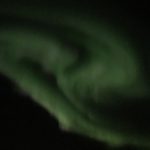
Aurora. Photo by Jane Suiter
I arrived on a Sunday. My friend, Brenda, is a teacher and had to work Monday and Tuesday of Thanksgiving week. She has an app that tracks the possibility of Northern Lights occurring in the Eagle River, AK, area. Her bedroom was upstairs and mine was on the main level. At 11 p.m. the first night she texted me to see if I was still awake. I don’t usually go to bed before midnight so I was. She asked if I wanted to go check out the Northern Lights. I knew she had to work the next day and I was impressed that she was willing to go check them out.
We drove up Mount Baldy so we would have an unobstructed view of the sky. When we got to the top we weren’t the only ones there. Other people had gathered to see the lights. Fortunately, we found a parking place in the crowded lot. We were not disappointed. The Aurora Borealis was spectacular. The light show lasted about 15 minutes. Most of the color was green but every once in a while, we were treated to some other colors. A continuous wave of light danced across the sky. It was amazing and something I won’t forget.
Experiencing the Dark
My second reason to visit in winter occurred every day. I wanted to experience the short days of winter in the north. Sunrise was around 9:15 a.m. and sunset was around 4 p.m. I didn’t have a problem with the 4 p.m. sunset but didn’t like the 9:15 a.m. sunrise. I would like to go to work in the sunlight and don’t mind coming home in the dark. This span of sunshine time would bother me if I lived there.
Feeling the Earth Move Under My Feet
My third reason to re-visit Alaska happened on the day I was scheduled to leave. I have traveled to California several times and have never felt an earthquake. As a retired earth science teacher, I wanted to experience an earthquake without damage or fear for my life.
The day it happened in Alaska, I was sitting at the table and all of a sudden everything started shaking. It was an earthquake! The epicenter was about 100 miles away and it was a 5.1 on the Richter scale. The shaking lasted about 10 seconds and some of the items on the bookshelves were vibrating. It was an interesting sensation, to say the least.
Spectacular Views
For anyone visiting Alaska one of the sites to see is Denali, the mountain. It is a rare opportunity to see this mountain. In June we could see it from afar on our way back to Anchorage. I took a bus tour into the park but it was a cloudy and rainy day so no mountain view. We took a train from Anchorage to Talkeetna to spend the night. On the way to Talkeetna, Denali was visible. The train even stopped so we could take pictures. When we got to Talkeetna, we walked around this small town. We found a spot along the river where Denali was still visible. It was a great site.
I loved my winter trip to Alaska and I think you will, too.
-
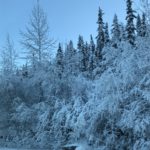
-
Frost covered trees.
-
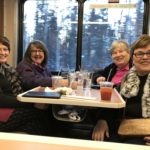
-
Jane with friends on the train.
-
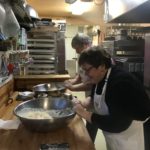
-
Making pies!
-
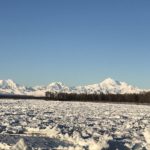
-
“The Great One” from the indigenous Koyukon language.
by Winding Pathways | Sep 6, 2018 | Travel/Columns

Superheros abound!
Colors, Costumes, Customs, and Carvings all coalesced at the Anchorage Museum on a cold winter’s day. On my first visit to this amazing city tucked into the head of the Cook Inlet, we took a break from all things outdoors in the winter, to tour this vast museum. Each wing presents a different aspect. The Smithsonian Arctic Studies Center, A Discovery Center, Planetarium, Art of the North Galleries and my favorite, the Alaska Galleries. This gallery artfully tells the story of Alaska Natives, settlement and the future.
The moment I stepped into the Alaska Galleries, I felt the spirit of the indigenous peoples. Their stories told through many voices and perspectives guide visitors through the rich history of this vast and uncompromising land. The exhibit is visually and auditorily stimulating. Almost overwhelming. So, I found it best to sit, close my eyes and listen to the messages below the surface. “What you do not see, do not hear, do not experience, you will never really know.” (Iyaaka Lore of St. Lawrence Island. Echoes of our Eskimo Elders.)
I tried to seat myself in openness to the subtle messages.
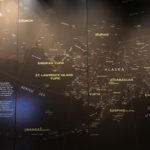
Map of First People regions
Interesting to me was the similarities in stories, clothing and equipment and the sense of belonging to each other and to the land. Yet, how they manifested depended on the richness of the region. Far Southeast Alaska tribes, that benefit from a milder climate and plentiful ocean and land resources seem to have more richly woven fabrics and elaborate costumes. The interior tribes live closer to the edge of subsistence as their artifacts showed. One intriguing display was a map of Alaska Natives and compared a spoon design from each of the cultures. Some were elaborate. Others simple.
Much effort has gone into helping to blend traditional life with the modern reality so that youth can live successfully in both worlds. “We’ve lost a whole generation of culture, but now it’s coming back.” (Maria Turnpaughl Unangax)
The overall message I received is” “We are connected”. All things have gratitude and that to “give gifts to others (is important for) it comes back to you.”
Another great display was of how transportation transformed Alaska. From rugged trails to shipping routes to overland methods to the advent of air travel. The overall message there is that whoever controls Alaska, controls the world. It is a pivotal point of communication and transportation.
This is an overview of just two of the Anchorage Museum’s Galleries.
Tucked away in a neighborhood is the Alaska Jewish Museum. This small museum shares the story of Alaskans helping rescue Jewish refugees. Alaska Airlines took the lead in these dangerous humanitarian missions.
The Anchorage Concert Series attracts the hottest shows. The Anchorage Symphony delights patrons with high quality programs.
The Anchorage International Film Festival always has something new and different brewing to warm winter clients yearning for quirky and exciting.
So, take a look at winter in Alaska – Anchorage especially – and remember that whether you are a winter outdoor enthusiast or a “curl up with a good book inside” winter enthusiast, Anchorage will warm you up.
-

-
The Alaska Museum warms your spirit.
-
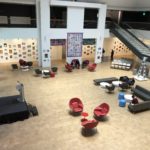
-
The foyer hosts many events.
-
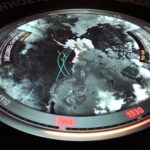
-
Interactive display of transportation to Alaska.
-
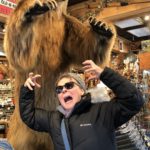
-
Playful Bear
by Winding Pathways | Jul 12, 2018 | 1080 Labyrinth Blog, Nature, Travel/Columns, Wonderment
A Guest Blog by
Teri Petrzalek
Background Information:
Sunnylands is the 200-acre estate outside Palm Springs of Walter and Lenore Annenberg. In 2001 they created a trust fund to “address serious issues facing the nation and the world community.” A 25,000 square foot, Mid-Century marvel, this peaceful oasis is set in the center of a 9-hole golf course. The property is now used for retreats as well as high-level summits. Former President Obama met Chinese President Xi Jinping. Other dignitaries include the Reagans, Prince Charles and Margaret Thatcher. The work of the Foundation is committed to sustainability, Global Cooperation, Democratic Institutions and Global Health and Food Security.
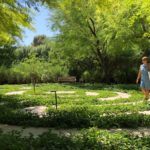
A hint of Thyme.
A visitor center was constructed at the entry and with it several breath-taking garden vignettes. As we toured the gardens, the tree-lined path around the great lawn opened to a clearing which contained a labyrinth. The 7-circuit path was wide and separated by low plantings.
To finish reading this guest blog, go to 1080 Labyrinth of Recovery and Laughter.
by Winding Pathways | Apr 26, 2018 | (Sub)Urban Homesteading, Foraging, Travel/Columns
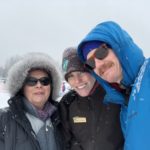
At the Iditarod Start
Food in Alaska is just plain fun! The Last Frontier state has one of the most ethnically diverse area codes in the country. English, Irish, Scottish, German, French, Norwegian, Swedish, Dutch, Polish, Filipino, Hawaiian, Samoan, Tongan, African Americans, Laotians, Japanese, Vietnamese, Indian, Chinese, Native American, Italian, Mexican and Russian are among the many groups of settlers. Alaska Natives with their several family identifications make up even more diversity.
And, as the spring 2018 issue of “Bake From Scratch” magazine points out, each cultural group brought its own type of food which has since fused into uniquely Alaskan fare. I sampled lots the few days I was in Alaska this winter. Some from different cultures and some from the subsistence foraging that is part of being Alaskan.
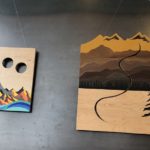
Art on a wall
My daughter and son-in-law hosted me for a fun Fur Rondy-Iditarod time in March. At a charming downtown restaurant, we enjoyed the wall art being prepped for “First Friday” when art galleries and restaurants feature new art, stay open for music and sometimes introduce new dishes. Tomato bisque and roll and grilled cheese sandwiches hit the spot on a cold and grey late winter day.
After walking off the lunch we hit Wild Scoops for their truly Alaskan sourced ice cream of “wildly” exciting flavors. From the micro-creameries to the harvested berries they boast ingredients from Alaska in generous Wild Scoops portions. We then wandered through the Alaska Museum to walk off those calories.
On the morning of the Iditarod, the first order of business for Brian and me was the stop at the Fire Island Rustic Bake Shop. This truly family affair of making traditional and specialty breads, muffins and scones using organic ingredients was a delight to see and smell. Lines out the door gave a clue to the popularity and was worth the wait to select a roll and coffee for the walk up to the Ceremonial Start. We saved a muffin for Nancy who was working at Campbell Creek Science Center where the Ceremonial Start ends at the Campbell Airstrip.
While not particularly “ethnic” the hotdogs for sale by vendors at the downtown Ceremonial Start of the Iditarod had long lines waiting with numerous sauces and spreads to tempt the taste buds.
-

-
Tasty treats!
-

-
Artisan Breads ready to buy.
-

-
New and different foods!
-
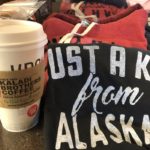
-
Coffee!
A trip to New Sagaya market was an eye-opener. So many choices from so many countries and cultures within each country. We snacked on interesting appetizers while we sipped great coffee. Poke – Hawaiian for slice or section – can be both a fish salad and an appetizer. We ate aku a raw oily tuna. Well, it was OK to try – once. Mochi is a round rice ball. Kind of soft and squishy. It had a subtle sweetness. Mike Barnes, Chief Operating Officer, accurately boasts, “NEW SAGAYA DOES WHAT NOBODY ELSE WANTS TO DO…WE GO THE EXTRA MILE.” Indeed, they seem to! Friendly, knowledgeable and the store is well-stocked with about any diverse food customers could want.
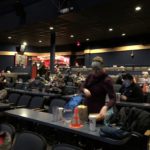
Waiting for the movie to start.
The Bear Tooth Theatre Pub is a “have to visit” place to eat and sample craft beers while watching first run, indie and foreign films. Broken Tooth Beer served there is just one of the best! And the pizzas are loaded with great locally sourced toppings on a crispy yet substantial crust. And, the popcorn…of course! Have to take it in. The background is that a few “fresh-faced college friends” concocted the idea of The Theatre Pub in the late 1990s. They gave up lucrative careers in computers and law when craft beers were coming of age and have been going strong since.
Not only did we eat out, but also, Nancy and Brian prepared wonderful meals at home. Most Alaskans forage and they are onto this one. They’ve had great adventures halibut fishing, picking berries and making jams and chutneys. Brian has plans for fall hunting and fishing expeditions. Meanwhile, they served elk and moose from previous trips, halibut tacos, Dutch Babies with their jams, and salmon from a neighbor. One friendly fact about Alaskans I learned is that if someone offers to help or offers food, say, “Yes. Thank you.” Alaskans mean it when they offer.
-

-
Moose and elk with greens and side dish.
-

-
Beautifully presented dinner.
-

-
We enjoyed wonderful home cooked meals.
Alaskans I met are genuinely friendly and use organic and local products as much as possible. Always, the dishes are infused with a truly Alaskan personality – We are Glad you are Here!
by Winding Pathways | Nov 16, 2017 | Travel/Columns
TRAVELING WITH BINOCULARS
Disclosure: Years ago we were asked to serve on the Alpen Optics Birding Pro-Staff and periodically we receive optics to test. Following is a report on using mini-binoculars while traveling.
In October we enjoyed a 1600-mile, 12-day clockwise loop around Washington State. After picking up our rental car at the Spokane airport our journey took us through deserts, mountain passes, the Olympic rainforest, and even across Puget Sound on a ferry.
We enjoyed spotting new bird species, sea lions, jellyfish, Roosevelt elk, and a host of other wildlife. Good thing we brought along binoculars! We wouldn’t dream of traveling without binoculars and use them constantly. Even when we trek to New York City we tote along a pair. But, for this trip, they presented a dilemma.
We wanted to avoid checking baggage on the plane to save cost and the possibility of a lost suitcase.
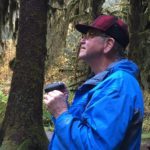
Rich with compact binoculars.
Delta Airlines limited us to a small suitcase that we could carry on the plane. Squeezing nearly two weeks’ worth of clothes and supplies into these packs was a challenge. It became obvious that we couldn’t fit in our full-size binocs. Mini Binoculars to the rescue! Our Alpen Wings ED compact binoculars easily nested into a hiking boot that we tucked in the pack.
For all around general binocular use, and when we’re traveling by car, we always use full-size binoculars. They fit our hands well, provide a bright image, even at dawn and dusk, and their field of view is wide. Their downside is bulkiness.
Many optical companies sell high-quality compact binoculars. Go for quality. Inexpensive models are nearly useless. Here are the pros and cons of mini binoculars:
PRO
Compact binoculars are handy because they are small. They easily fit in a glove compartment, purse, or jacket pocket and take little space in a suitcase. Mini’s are ideal for travel. Quality ones have clear optics.
Having a pair of mini binoculars handy is always better than not having binoculars.
CON
Mini binoculars have a limited field of view and are rarely as good in low light situations as their full-size cousins. We find them a little harder to use and hold than full-size models and would never choose to use minis for long viewing sessions or if we went on specific birding excursions. But they are invaluable when size and weight are limited.
The best solution is to have two pairs of binoculars. One full sized model for general use and minis for travel and convenience.
by Winding Pathways | Aug 23, 2017 | Travel/Columns
Even though clouds and rain dominated the central Midwest on Monday, August 21st, we took in and enjoyed our Eclipse Trip 2017. We drove major roads to SW Iowa and cut over to smaller state and county roads where the views were more intimate and traffic less. Rolling hills of the Iowa Southern Drift added variety for the eye and pastures and unmowed roadsides softened the landscape, providing habitat for pollinators and birds. This is a very low population area of Iowa. Only about 7000 people live in the entire county and Bedford, IA, has been losing population since the 1930’s. You can buy a house there for $25,000.
Our campsite at Lake of Three Fires near Bedford, IA was surrounded by other eclipse seekers. Set on fingers of ridges, the campground would normally have been empty on a Sunday night, but on the solar eclipse eve, campers kept streaming in. All quiet. All intent on finding a good location to view the upcoming eclipse. Met many folks from Minnesota had braved I-35 and I-80 traffic and a terrifically scary and strong lightning storm that blasted through southern Iowa and lit the sky all night. One fellow pulled in at 4:00 a.m. The night brought a chorus of coyotes, a lone owl hooting and an amazing lightning show to the north.
Then, the rain. But, that did not deter any of us. We scattered across NW Missouri and doggedly drove toward clearing skies, finding a small window in Maysville, MO. The rain stopped, clouds thinned and we set our chairs up on the lawn of the county courthouse along with a bunch of other folks. Eclipse watchers clustered about along gravel roads, in farms, and in small towns.
We were able to see the sun on and off through thin clouds. While we had only glimpses of the sun itself as the moon “took bites out of it”, the experience and the surrounding activities were fascinating. The day gradually darkened and then just at totality it went black! Street lights came on. Nighthawks appeared in the sky and chimney swifts circled chimneys. Pigeons roosted on the roofs. Bats briefly fluttered about. People donned their glasses, chatted, and “oohed” and “awed” exclaiming loudly, “I can’t believe this!” “How cool is this?!” And, finally, one woman joked, “Why are we all so surprised?”
After a couple of minutes it got lighter rather quickly and we hopped in to car for the 270 mile drive back home.
It was one fun trip and a lovely diversion from the regular fare of “news” that we are subjected to daily.
More anon. Enjoy this short Splice video of our trip.
-
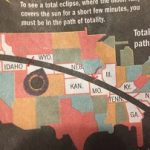
-
X over Wyoming = Nancy and Brian; X over NYC = Dan and Amy; Arrow to MO = US!
-

-
First train robbery.
-
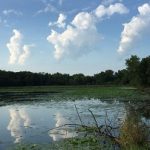
-
Lake of Three Fires
-
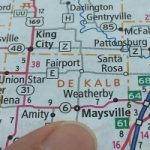
-
NW Missouri
-
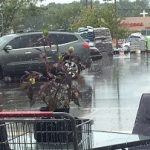
-
Relentless rain over the central Midwest.
-
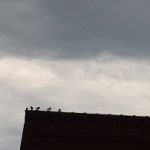
-
1:00 p.m. and birds were roosting, bats flying and nighthawks calling.





























